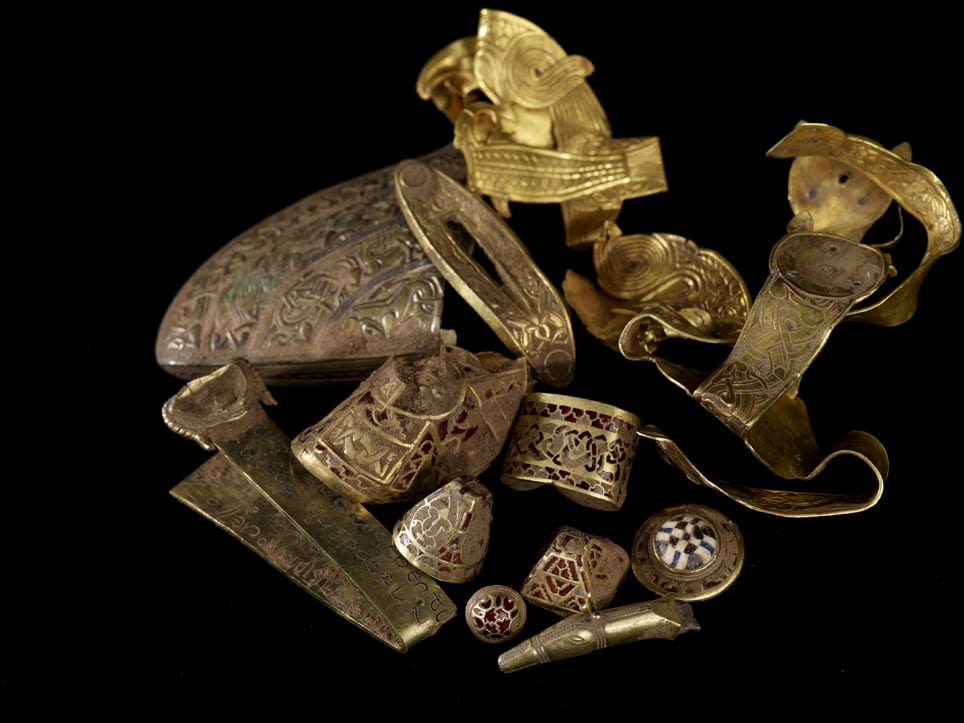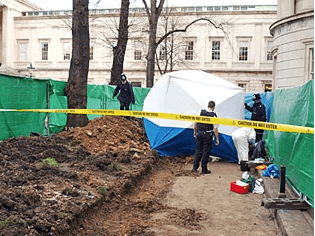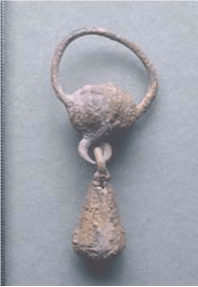The Staffordshire Hoard: Defining “Treasure”
By Gemma Angel, on 14 January 2013
 by Felicity Winkley
by Felicity Winkley
In July 2009 in a field in Hammerwich, Staffordshire, Terry Herbert stumbled upon the largest hoard of gold and silver Anglo Saxon metalwork ever found. Comprising over 3,500 items, the Staffordshire Hoard – as it is now known – totals some 5.0 kilos of gold, 1.4 kilos of silver and 3,500 cloisonné garnets.[1] It is almost exclusively war-gear, save for two or possibly three crosses, the largest of which has been folded. The sheer quantity of finds in the hoard and their exquisite workmanship have caused archaeologists to speculate that what we know of 7th century metalwork may have to be completely rethought – and all this from a find that was literally sitting on a field surface due to be ploughed into oblivion. Today the Staffordshire Hoard is back in the news: last November, again after the field had been recently ploughed, a team from Archaeology Warwickshire found a further 91 associated objects[2], and just 2 weeks ago, 81 of these were ruled to be treasure at a coroner’s inquest.[3]

A selection of objects from the Staffordshire Hoard, including the folded cross.
Photograph © Portable Antiquities Scheme.
I had already been thinking about treasure, in light of the Researchers in Museums project, as a potential point on which to engage people with my research at the Petrie Museum. ‘Treasure’, I thought, could be useful for capturing visitors’ imagination, evoking chests of gold doubloons on desert islands, or hoards of jewels guarded by slumbering dragons. Indeed, as a noun the Oxford English Dictionary defines treasure as: ‘a quantity of precious metals, gems, or other valuable objects’.[4] A quantity, gosh!
At first glance, however, the crowded cases at the Petrie Museum might not seem to boast many objects which we would hasten to describe as treasure – certainly few of the portable antiquities match the criteria laid out in the UK’s Treasure Trove legislation (but more on that later). And yet here the verb of treasure becomes useful, for amongst those ‘Objects of Daily Use’ (as Petrie classified them) are numerous personal items which would certainly have been treasured – ‘kept carefully’, and valued’ (see note 4) – by their owners: miniature vases for storing cosmetics, earrings, necklaces, shabtis, votive figurines… So how do we define treasure, and does it really matter?
The answer to the latter, in terms of England’s archaeological record, is clearly yes, it does matter. Until it was addressed relatively recently, the legislation of “Treasure Trove” had existed as common law for centuries, originally as a means for the Crown to claim any riches found. The three basic elements are as follows: the found object must be made of, or contain a ‘substantial’ amount of gold or silver; have no known original owner (or heir); and have been buried with the original intention that it would be later recovered (known as animus revertendi).[5] As Cookson suggests, ‘Treasure Trove was conceived long before archaeology gave cultural value to old things, and considers valuables from an essentially financial perspective, not an artistic or historical one’.[6] Indeed, we can see how protection was scant: anything not rendered in precious metal was disqualified, and once an object was precious metal, it had to be proven that someone had buried it with an intent to return to it (quite a task!). In the light of increasing concerns from archaeologists and heritage professionals – fuelled in no small part by the extreme increase in the popularity of metal detecting during the 1970s and ‘80s – the legislation was overhauled in 1996. Enforced on the 24th September 1997, the new Treasure Act set out to ‘abolish treasure trove and to make fresh provision in relation to treasure.’[7]
The definition now covered the following:
- Any object at least 300 years old, other than a coin, found to contain at least 10% precious metal;
- All coins at least 300 years old from the same find which number, in the case of base metal coins, more than 10 or, in the case of gold and silver ones, more than 2;
- Any object of whatever composition found in the same place as, or that had previously been together with, another treasure find;
- Any object, not falling into the 3 categories above, that would previously have been treasure trove, namely modern coin hoards or similar displaying animus revertendi [8] (see also note 7).

The Crosby Garrett helmet, a Roman helmet
metal-detected in Cumbria and sold at auction
to an anonymous buyer, because it was not
saved for the nation as treasure (see note 11).
Since then, prehistoric base metal assemblages have also been added to the Treasure Act, and the UK’s portable antiquities are better protected than ever.[9] The Portable Antiquities Scheme, a voluntary recording scheme set up in concordance with the Treasure Act has, since 1997, recorded 831,595 objects (both treasure, and otherwise) found outside of archaeological excavation – mostly by metal detectorists.[10] However, many would like to see the treasure legislation tightened further still, especially in light of recent landmark base metal finds, such as the astonishing Crosby Garrett Roman helmet, which was lost to a private vendor on account of its not qualifying as treasure. The fundamental question therefore still remains: what does treasure mean and, more importantly, what will it mean to future generations?
References:
[3] http://www.bbc.co.uk/news/uk-england-stoke-staffordshire-20903152
[4] http://oxforddictionaries.com/definition/english/treasure?q=treasure
[5] N. E. Palmer: ‘Treasure Trove and Title to Discovered Antiquities’, in International Journal of Cultural Property 2, (1993), pp. 275-318.
[6] N. Cookson: ‘Treasure Trove: dumb enchantment or new law?’ in Antiquity 66 (1992), pp. 399-405, (p.401).
[7] Department for Culture Media and Sport: The Treasure Act 1996 Code of Practice (Revised) England and Wales, (2002) London: DCMS (pp.22).
[8] R. Bland: ‘The Treasure Act and the Proposals for the Voluntary Recording of All Archaeological Finds’, in The Museum Archaeologist 23 (Conference Proceedings) (1996), pp.3-18.
 Close
Close










